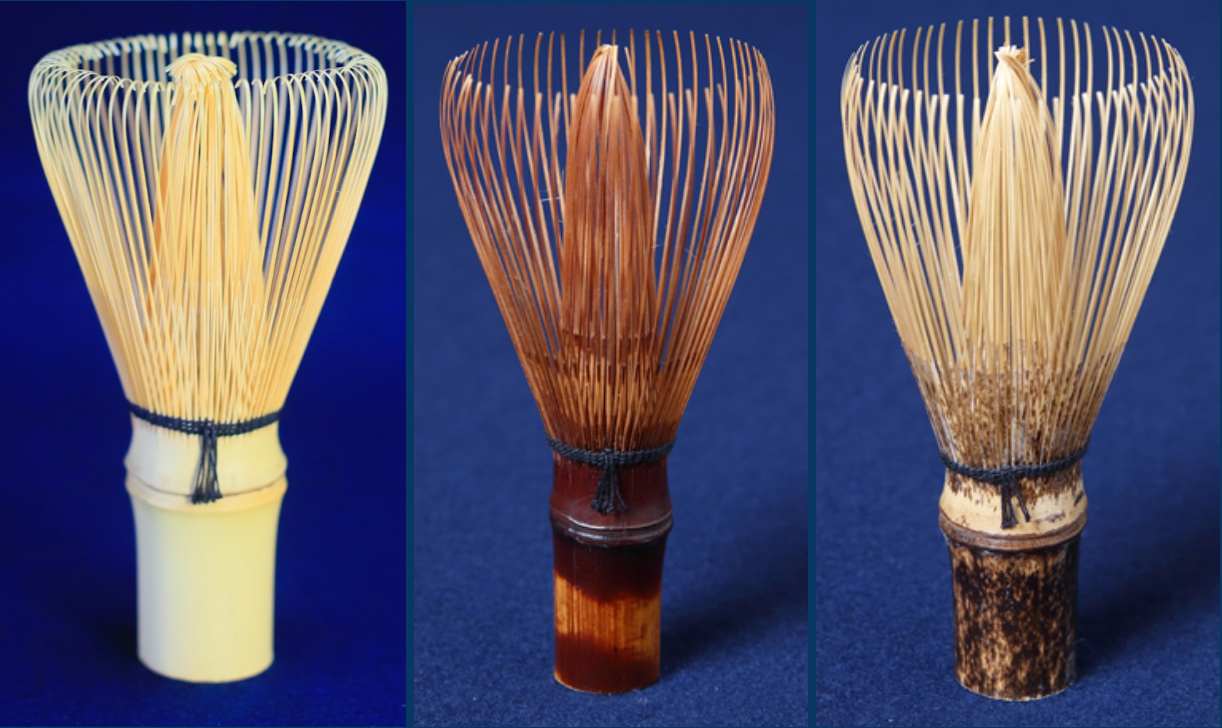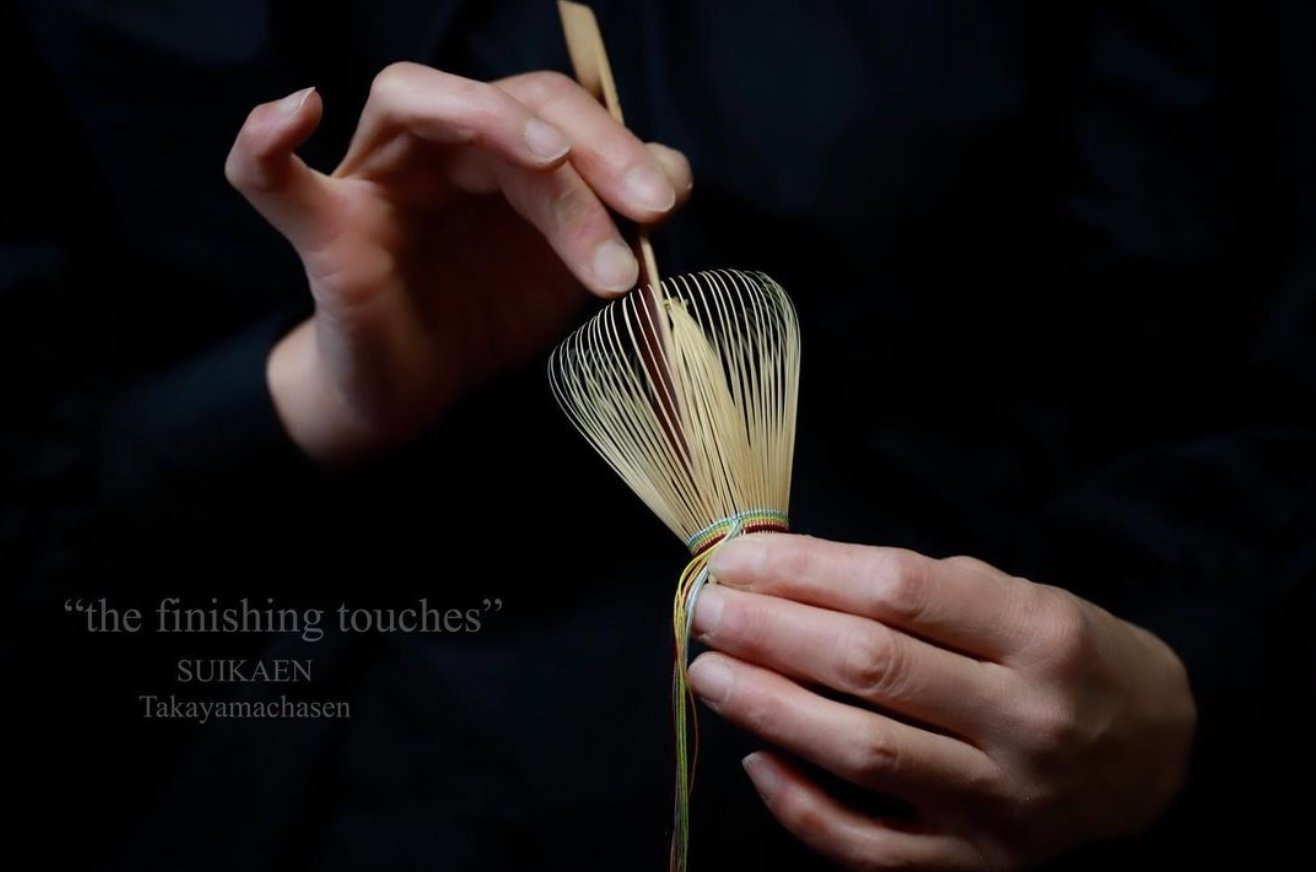今日は、抹茶を点てる際に欠かせない、茶筅(ちゃせん)について、特に茶筅作りに使われる竹についてお話したいと思います。茶筅は私たちにとって当たり前のものかもしれませんが、抹茶の粉を均一に混ぜ合わせ、クリーミーな泡を作る茶筅の力は実に素晴らしいものです。しかも、茶筅はたった一本の竹から作られ、その竹は60~120本の繊細な竹筋に分かれているというから驚きです。
茶筅作りの歴史
茶筅の起源と歴史について簡単に触れると、中国の宋代には、粉茶を泡立てる「點茶」を点てる茶筅のようなものが使われており、それが後に日本に伝わったと言われています。しかし、この茶筅の外観や使用方法については不明瞭な点があります。日本の茶筅に関する最初の記録は 、室町時代中期(1336年 - 1573年) 、足利義政が8代将軍だった時代に遡ります。伝説によると、茶人の村田珠光が親友で高山城主の次男である入戸宗水に最高級の茶筅を求めたのが、日本の茶筅作りの始まりと言われています。
村田珠光は高山称名寺の僧侶でした。茶人であっただけでなく、詩歌(連歌や和歌の名手)、書道でも名を馳せ、侘び茶の創始者、茶道に大きな影響を与えた人物として広く知られています。この茶筅は村田珠光が京都に移り住んだ後富美院天皇に入道宗水から献上されたものです。天皇はこの手造りの精緻な茶筅を大変お気に召し、「高峰」(後に高山茶筅と呼ばれる)と名付けたと伝えられています。宗水はこのお褒めの言葉に深く感銘を受け、以後茶筅作りに専念することとなり、茶筅は高山家の名物工芸品となりました。
それ以来、高山の茶筅職人たちは技を磨き、何世代にもわたってその熟練の技を伝えてきました。今日、茶筅職人の中には18代目、あるいは25代目もいます。残念ながら、日本の多くの貴重な職人技と同様に、茶筅作りの技術も衰退傾向にあります。実際、今日の抹茶筅のほとんどは日本国外で大量生産されています(大部分は中国製です)。しかし、最高品質のものは、500年以上もの間、奈良県高山の小さな村で地元産の竹から今も作られています。約18人の茶筅職人が今も残っており、家族の伝統を受け継いでいます。Yunomiニュースレターをご覧になっている方はご存知かもしれませんが、今年6月には25代目の職人である翠花園谷村安三郎氏をYunomiコレクションに迎えました。この伝統的な職人技が失われるのを防ぐため、これらの家では家族以外から弟子を取るようになってきています。
 奈良県高山村翠華園の茶筅職人、谷村安ぶろう氏。
奈良県高山村翠華園の茶筅職人、谷村安ぶろう氏。
茶筅作りの根源、竹
まず、竹そのものについて少し触れておきます。竹はイネ科( Poaceae )に属する常緑多年生植物です。世界には約1,500種の竹があり、そのうち約600種が日本に生息しています。竹は温暖多湿の地域で急速に成長します。実際、日本の農村部では農家が伝統的に行ってきたような適切な管理が行われず、多くの種が急速に拡散し、現在では日本に生息する種の半分が侵略的外来種とみなされています。
竹は草なので、樹木のような形成層を持たず、同じ幹が季節ごとに太くなることはありません。一本の幹は5~10年しか生きられませんが、竹林全体は数十年、通常は花が咲くまで生き続けます。興味深いことに、竹林の竹は60~120年に一度、一斉に花を咲かせます。花が咲くと(これは非常に特殊な現象です) 、竹林全体が枯れてしまい、回復には約10年かかります。
毎シーズン、地下茎から新しい芽(稈)が出てきます。2年目以降は、稈の上向きの成長は緩やかになりますが、竹の内側(肉の部分)はより強く硬くなります。しかし、これには限界があり、7年ほどで脆くなるという説もあります。そのため、工芸品に使われる竹のほとんどは、3年から7年の間に作られます。茶筅に使われる竹は通常3年ものです。
竹の魅力的な特性
竹には独特の抗菌作用と消臭作用があることが知られています。日本では、乾燥したタケノコの皮はおにぎりを包むのに使われたり、精肉店では肉を包むのに使われたりしました。近年、竹の抗菌作用は科学界からも注目を集めており、竹エキスの抗菌作用を調査する研究も行われています。消臭作用に関しては、野生のクマが獲物から自分の匂いを隠すために竹の葉を食べていたと言われています。実際、竹を主食とするパンダの糞は無臭であることはよく知られています。また、竹は強くしなやかな性質も魅力的です。箸、まな板、スコップ、籠、ザルなど、様々な伝統的な家庭用品に竹が使われていることからもそれが分かります。これらの竹の優れた特性は、茶筅を作るのにも非常に適していることを反映しています。
茶筅作りに使われる竹の種類
日本には数百種の竹がありますが、茶筅用の竹には特別な条件が求められます。茶筅は通常、晩秋に3年生の竹を伐採し、2ヶ月間天日干しして作られます。この寒天乾燥は「寒干し」と呼ばれます。 寒干し。文字通り「冷たく乾燥させる」という意味です。茶筅作りの伝統産業である奈良県高山市では、500年もの間、寒干しは美しい冬の風物詩となっています。
 奈良県高山村の翠花園では、雪景色が美しさを引き立て、竹を寒干ししている風景が広がっています。
奈良県高山村の翠花園では、雪景色が美しさを引き立て、竹を寒干ししている風景が広がっています。
日本茶を淹れるのに最適な環境があるように、山間部に位置する高山の穏やかな日差しと涼しい風は、竹を丈夫で艶やかな光沢に仕上げます。高山の茶筅職人たちは、化学薬品やカビを一切使わずに育てられた良質の竹を厳選。写真のように冬の間天日干しした後、さらに2年間蔵で乾燥させます。この間に折れたり曲がったりした竹は取り除かれるため、茶筅の原料となる竹は厳選されたものです。実は、茶筅職人が技術を習得する過程で、茶筅となる竹を見分けることが、最初に求められるスキルの一つなのです。
 選別した竹を大きな鍋に入れて煮る工程は「油抜き」と呼ばれます。熱と水に浸した竹の重さのため、非常に手間のかかる工程です。この工程で竹は洗浄され、土などの自然由来の粒子が取り除かれます。また、竹に含まれる余分な油分も除去されるため、竹の耐久性が向上します。その後、冷間乾燥が行われます。
選別した竹を大きな鍋に入れて煮る工程は「油抜き」と呼ばれます。熱と水に浸した竹の重さのため、非常に手間のかかる工程です。この工程で竹は洗浄され、土などの自然由来の粒子が取り除かれます。また、竹に含まれる余分な油分も除去されるため、竹の耐久性が向上します。その後、冷間乾燥が行われます。
茶筅の最終的な見た目は、使用する竹の種類によって決まります。茶筅は通常、白竹(しらたけ)、煤竹(すすたけ)、黒竹(くろたけ)の3種類の竹から作られています。中には真竹(まんだけ)から作られるものもあります。以下の茶筅の画像では、形、色、歯の仕上げのカーブ、そして歯の中央の結び方に違いが見られます。
 翠花園の茶筅の一部。使用されている竹の種類が表現されています。左から白竹、 薄竹、 黒竹/紫竹。
翠花園の茶筅の一部。使用されている竹の種類が表現されています。左から白竹、 薄竹、 黒竹/紫竹。
白竹は最も一般的で経済的な種類の竹で、小さめだが維管束が多いため、茶筅を作るのに適しています。表面は細かく密度が高いですが、折れやすいです。一方、黒竹は抹茶筅を作るための最も頑丈な材料です。密度が高いため、彫刻が非常に困難です。しかし、より耐久性があり、通常の白竹茶筅の3倍の寿命があります。煤竹は、何十年、時には何世紀も(100年から200年)調理用の火の煙で染まった竹であるため、ユニークで珍しい竹です。日本の伝統的な家屋では、これらの竹の茎は茅葺き屋根に使われていました。 これらの家の囲炉裏の上や近くの竹の茎は、徐々に独特の自然な茶色に染まり、これらの屋根が取り替えられたときに、竹は茶筅職人に売られ、高品質の茶筅や茶杓に加工されました。現在では大変希少で貴重なものと考えられています。伝統的な日本家屋の数が減少傾向にあるため、残念ながらこのタイプの家も時とともに姿を消す可能性があります。
茶筅作りの芸術
茶筅の歴史と茶筅作りに使用される竹について触れたところで、いよいよ茶筅がどのようにして美しい形を成すのか、その詳細に触れたいと思います。竹を乾燥させた後、原料の竹が繊細な茶道具へと変化していく過程には、約8つの工程があります。伝統的な茶筅職人が、小刀と専用の道具(もちろんこれも竹製です)を用いて、一つ一つ手作業で茶筅を作り上げます。
 翠花園の茶筅作りの工程を写真でご覧いただけます。 工程を撮影した動画もご覧いただけます。
翠花園の茶筅作りの工程を写真でご覧いただけます。 工程を撮影した動画もご覧いただけます。
1.原竹(はらたけ):最初のステップは、竹を12cm(4.5インチ)の長さに切り、節を長さの約3分の1のところに置いて、竹を2つの部分に分けることです(上の画像の最初のステップを参照)。長い方が枝の部分、短い方が柄の部分になります。
 原竹の第一段階:選別した竹を茶筅を作る長さに合わせて切る。
原竹の第一段階:選別した竹を茶筅を作る長さに合わせて切る。
2. 片木(かたぎ):次の工程である「片木」では、茶筅職人が、茶筅の先端から中間部分の皮を削り、茶筅の形を整えていきます。ここから、茶筅の先端部分を半分まで16の部分に分けます。次に、職人は各部分を折り曲げ、包丁を使って硬い外皮と柔らかい内果を切り離し、取り除きます。
3.小割(こわり):竹の穂をさらに割ること。茶筅の種類によって、16本の節をさらに2回から8回に分けて割ります。こうして出来上がる茶筅の穂の数は36本から120本になります。竹を80本から100本の極細穂(最も細い部分で0.1mm以下)に丁寧に割る技術は、並外れた集中力と熟練の技、そして大変な労力を必要とします。実際、熟練の職人でさえ、1日に6~7本程度しか作れません。
4. 味削り:すべての竹の穂先を切った後、筍を熱湯に浸して竹を柔らかくします。職人は穂先を根元から先端にかけて削り、最後の1~2cmは細く、しなやかで透明感のある状態になるまで削っていきます。このしなやかな穂先は内側に丸まり、独特の繊細な形に整えられます。これは最も重要な工程の一つであり、長年の鍛錬と鍛錬が必要です。 実際、職人が茶筅に柔軟性を加えることで、抹茶の泡立ちがよくなるのです。
 翠花園の谷村弥三郎氏の作業場を撮影した写真。抹茶の味はこの「味削り」の工程で決まると言われています。写真の小刀は、この工程で使われる唯一の道具です。この繊細な工程の前に、職人は必ず小刀を研ぐことから始めます。
翠花園の谷村弥三郎氏の作業場を撮影した写真。抹茶の味はこの「味削り」の工程で決まると言われています。写真の小刀は、この工程で使われる唯一の道具です。この繊細な工程の前に、職人は必ず小刀を研ぐことから始めます。
5. 面取り(めんとり):職人は、それぞれの歯の長い端からわずかな量の材料を削り取り、粗い部分を取り除きます。これにより、抹茶が歯に付着するのを防ぎます。
6.下編 (したあみ):歯を削った後、糸を歯の周りを前後に織り込み、歯を内輪と外輪に分けます。歯の半分が内輪になり、残りの半分が外輪になります。
7. 上編み(うあみ)×2:糸を2列追加して全体を固定し、泡立て器の前側で結びます。この糸は黒が一般的ですが、様々な効果や場面に合わせて異なる色を使うこともできます。
8. 仕上げ:職人は、この時点では広がった泡立て器の歯を微調整し、最終的な形に整えます。この工程では、多くの場合、内側の歯をねじって結び目を作ることになります。最後に、主任の職人が仕上げと検査を行い、すべての歯が均等な間隔で、均一な円を描いていることを確認します。

大量生産の抹茶筅とは異なり、高山茶筅は機械や化学薬品を一切使わず、すべて手作業で作られています。茶筅作りの技術を学ぶまでは、厳選された竹を冬の間に冷蔵保存するという工程から始まるとは想像もしていませんでした…。まだ高山茶筅で抹茶を点てたことはありません(とても楽しみです!)。しかし、伝統的な茶筅作りに求められる緻密な工程への理解が深まりました。
このブログ投稿の写真はすべて、奈良県高山村にある茶筅職人・谷村安三郎氏の工房「翠華園」より提供されました。美しく繊細な茶筅職人たちの技をぜひご覧になりたい方は、Instagramアカウントをフォローしてください。


